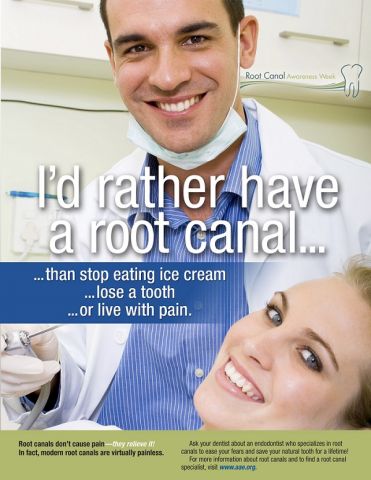 You may have heard of a root canal, but what do you know about the procedure? The purpose of Root Canal Awareness Week (March 30 – April 5, 2014) is to dispel the myths and mysteries surrounding this endodontic tool. Here’s what you should know about the process.
You may have heard of a root canal, but what do you know about the procedure? The purpose of Root Canal Awareness Week (March 30 – April 5, 2014) is to dispel the myths and mysteries surrounding this endodontic tool. Here’s what you should know about the process.
Let’s first understand a tooth’s structure, the crowns of the teeth are the part you use to chew, eat, and flash your sparkling smile. The crowns are covered by an enamel surface that must withstand the torture of hard candy, hot coffee, and cheeseburgers. Within the tooth is a soft material known as pulp where nerves, tissues, and blood vessels reside. Finally, the root is the part that extends towards your jawbone and is covered by your gums.
The tooth’s root or pulp can be damaged by many things. A small chip or crack in the enamel may allow bacteria to invade and destroy the tooth from within. Trauma from an accident is another common way the tooth can be destroyed. Decades ago, many people would lose teeth from these incidents. With today’s endodontic technology, most of those patients can now keep those troubled teeth after an expert root canal.
During the procedure, the area would be numbed so that you will not feel pain. The infected pulp is removed and the interior of the tooth is thoroughly cleaned, then filled and finally sealed. The result is a wonderful new tooth that looks and feels great. Dr. Jacqueline S. Allen of Phoenix Endodontic Group says “Brushing, flossing and regular dental checkups will help keep a patient’s mouth healthy after a root canal. Preventing decay is the key to having a root canal last a long time. Avoiding situations which put a tooth at risk for breaking will help also, i.e. chewing ice, sports injuries, etc.”
Most patients report minimal pain as a result of a root canal, comparing it to getting a filling. To reduce your risk of needing a root canal for an issue not related to trauma, “Brushing, flossing, fluoride, and regular dental checkups are effective,” says Dr. Allen.
